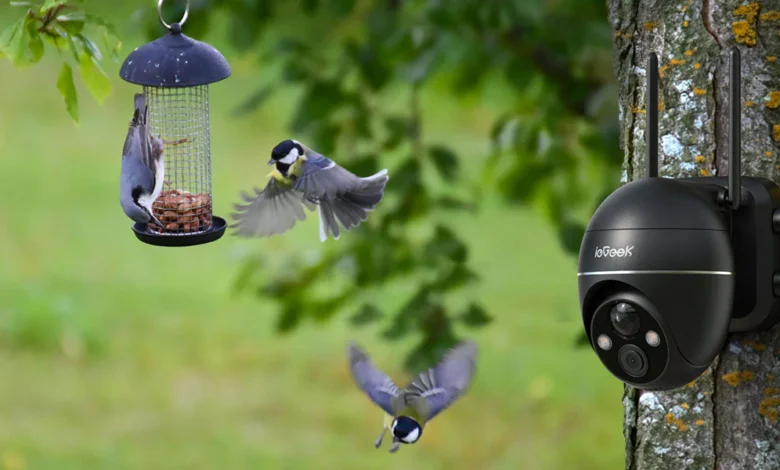Beyond Bird Watching: How the Best Bird Feeder Cameras Offer Insights into Backyard Ecosystems

Bird feeder cameras have rapidly evolved from niche birdwatching tools to essential gadgets for observing the hidden world of backyard ecosystems. While they’re known for helping users capture close-up views of beautiful birds, these cameras do much more. By monitoring feeders, bird feeder cameras provide insights into the delicate balance of backyard ecosystems, documenting interactions between various species and revealing patterns in animal behavior, plant growth, and seasonal changes. This article explores how bird feeder cameras go beyond birdwatching best bird feeder camera to offer a deeper understanding of the ecological dynamics in our own backyards.
Observing Bird Behavior and Biodiversity
Bird feeder cameras allow users to observe birds’ feeding habits, territorial behaviors, and social interactions up close. With many models featuring AI capabilities, cameras like the Bird Buddy 2.0 and Netvue Birdfy AI can identify species automatically, letting users document bird diversity over time. This feature allows enthusiasts to keep track of which best bird feeder with camera species visit their feeders and at what frequency, providing valuable data on biodiversity and helping identify any changes in species prevalence due to environmental factors like weather, food availability, or local flora changes.
This close-up observation can reveal surprising behaviors and social dynamics among bird species, such as:
- Feeding Hierarchies: Cameras capture how some birds dominate the feeder while others patiently wait for their turn, offering insights into the pecking order in bird communities.
- Seasonal Shifts: Users can document how different bird species appear with the changing seasons, noticing trends in migration, nesting, and foraging behaviors.
- Pair and Group Behavior: Bird feeders often bring pairs or groups, enabling users to observe courtship, mating behavior, and social interactions that provide a window into the family life of birds.
Tracking Other Wildlife Visitors
Bird feeders, along with the food they offer, attract more than just birds. Squirrels, chipmunks, insects, and even raccoons may frequent backyard feeders, providing an unexpected opportunity to observe a variety of wildlife behaviors. High-quality bird feeder cameras, especially those with motion detection, capture these non-avian visitors and their interactions with the feeder environment.
Some notable observations may include:
- Squirrel Problem-Solving: Many bird feeder camera owners have documented squirrels demonstrating impressive problem-solving skills to access food meant for birds.
- Predator-Prey Dynamics: Occasionally, hawks and other raptors might be drawn to the feeder as they search for prey. Witnessing this interaction reminds us of the natural food chain and the balance predators and prey maintain in backyard ecosystems.
- Symbiosis and Coexistence: Insects like bees and butterflies, attracted by certain bird food or plants around the feeder, can coexist with birds, sometimes serving as pollinators for nearby flowers or feeders.
These encounters showcase the richness of the ecosystem beyond birds, helping backyard enthusiasts understand the relationships among different species within the same environment.
Monitoring Seasonal Changes and Plant Growth
Bird feeder cameras serve as more than wildlife observers; they also act as subtle indicators of seasonal changes. With a consistent viewing area, users can observe how trees, shrubs, and flowers evolve with the seasons, capturing growth, blooming cycles, and foliage changes over time. These patterns can offer insights into:
- Plant Health and Growth Patterns: By observing the background of feeder areas, users can monitor nearby plants for signs of health, pest activity, or growth spurts. Some bird feeders attract pollinating insects, which can benefit plants in the area, indirectly supporting backyard gardens.
- Seasonal Shifts in Vegetation: Bird feeder cameras capture how flora changes with the seasons, revealing when leaves fall, when buds bloom, and how the environment responds to climate shifts.
- Environmental Impacts on Vegetation: Prolonged observation can reveal changes in plant behavior due to environmental stresses, such as droughts, heat waves, or cold snaps. These insights can help users understand how plants and animals in their yard adapt to changing conditions.
Understanding Feeding Patterns and Dietary Preferences
Bird feeder cameras reveal important insights into the feeding patterns and dietary preferences of birds and other wildlife. Through close observation, users can identify which food types are most popular, which are often ignored, and how preferences might change over the year. For instance:
- Diet Variation by Season: Birds may consume more calorie-dense foods during colder months, while opting for insects or berries in warmer periods. Observing these changes gives users insight into how wildlife meets its dietary needs in varying weather conditions.
- Favorite Foods of Specific Species: Some birds prefer specific seeds, while others may lean toward suet or nectar. Identifying these preferences can help users customize the feeder to attract desired species.
- Impact of Food Availability: By experimenting with different types and amounts of food, users can see how the presence (or absence) of food influences the frequency and duration of bird visits. Scarcity of food may lead to increased competition among species or fewer visits, highlighting the significance of resource availability in maintaining ecological balance.
These insights help bird enthusiasts create a more supportive feeding environment for birds, aligning feeder choices with birds’ seasonal dietary needs and contributing to the health of the local ecosystem.
Enhancing Environmental Awareness
Using bird feeder cameras allows people to engage with nature in a way that deepens their understanding of local ecosystems. Over time, this exposure fosters environmental awareness and empathy for wildlife, as users witness the interconnectedness of different species and the influence of human actions on nature. Notable environmental insights may include:
- Climate Awareness: Documenting bird behavior and seasonal plant changes over time can reveal shifts due to climate change, such as changes in migration patterns, earlier blooming times, or weather impacts on wildlife.
- Recognizing Local Biodiversity: By seeing which species appear and learning their preferences, users develop an understanding of the unique biodiversity in their region. This awareness is a powerful motivator for backyard conservation efforts.
- Sustainable Practices: Bird feeder best camera bird feeder cameras inspire people to adopt eco-friendly practices in their own yards, such as reducing pesticide use or planting native species to support birds and other wildlife.
Conclusion
Bird feeder cameras offer more than just beautiful snapshots of birds—they open a window into the broader ecosystem dynamics within our backyards. By documenting birds, tracking wildlife interactions, observing seasonal plant changes, and understanding feeding patterns, these cameras help users appreciate the intricate web of relationships that make up local ecosystems.
For backyard enthusiasts and conservationists alike, bird feeder cameras represent a powerful tool for exploring and preserving the natural world right outside the window. This deepened awareness brings value to our interactions with nature, reminding us that even small outdoor spaces are part of a larger ecosystem worthy of protection and care.



